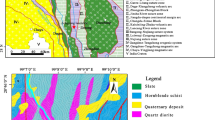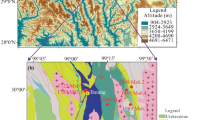Abstract
This paper presents a study on an ancient river-damming landslide in the SE Tibet Plateau, China, with a focus on time-dependent gravitational creep leading to slope failure associated with progressive fragmentation during motion. Field investigation shows that the landslide, with an estimated volume of 4.9 × 107 m3, is a translational toe buckling slide. Outcrops of landslide deposits, buckling, toe shear, residual landslide dam, and lacustrine sediments are distributed at the slope base. The landslide deposits formed a landslide dam over 60 m high and at one time blocked the Jinsha River. Optically stimulated luminescence dating for the lacustrine sediments indicates that the landslide occurred at least 2,600 years ago. To investigate the progressive evolution and failure behavior of the landslide, numerical simulations using the distinct element method are conducted. The results show that the evolution of the landslide could be divided into three stages: a time-dependent gravitational creep process, rapid failure, and granular flow deposition. It probably began as a long-term gravitationally induced buckling of amphibolite rock slabs along a weak interlayer composed of mica schist which was followed by progressive fragmentation during flow-like motion, evolving into a flow-like movement, which deposited sediments in the river valley. According to numerical modeling results, the rapid failure stage lasted 35 s from the onset of sudden failure to final deposition, with an estimated maximum movement rate of 26.8 m/s. The simulated topography is close to the post-landslide topography. Based on field investigation and numerical simulation, it can be found that the mica schist interlayer and bedding planes are responsible for the slope instability, while strong toe erosion caused by the Jinsha River caused the layered rock mass to buckle intensively. Rainfall or an earthquake cannot be ruled out as a potential trigger of the landslide, considering the climate condition and the seismic activity on centennial to millennial timescales in the study area.

modified from Cao et al. (2015))














Similar content being viewed by others
References
Bandis SC, Lumsden AC, Barton NR (1983) Fundamentals of rock joint deformation. Int J Rock Mech Min Sci & Geomech Abstr 20(6):249–268
Bao Y, Zhai S, Chen J, Xu P, Sun X, Zhan J, Zhang W, Zhou X (2020) The evolution of the Samaoding paleolandslide river blocking event at the upstream reaches of the Jinsha River, Tibetan Plateau. Geomorphology 351:106970
Ben-Zion Y, Zaliapin I (2019) Spatial variations of rock damage production by earthquakes in southern California. Earth Planet Sci Lett 512:184–193
Bozzano F, Martino S, Montagna A, Prestininzi A (2012) Back analysis of a rock landslide to infer rheological parameters. Eng Geol 131-132:45–56
Cao W, Yan DP, Qiu L, Zhang Y, Qiu J (2015) Structural style and metamorphic conditions of the Jinshajiang metamorphic belt: Nature of the Paleo-Jinshajiang orogenic belt in the eastern Tibetan Plateau. J Asian Earth Sci 113:748–765
Cavers D (1981) Simple methods to analyze buckling of rock slopes. Rock Mech 14(02):87–104
Chen J, Dai F, Lv T, Cui Z (2013) Holocene landslide-dammed lake deposits in the Upper Jinsha River, SE Tibetan Plateau and their ages. Quat Int 298:107–113
Cho N, Martin CD, Sego DC (2007) A clumped particle model for rock. Int J Rock Mech Min Sci 44:997–1010
Choquet P, Hadjigeorgiou J, Manini P, Mathieu E, Soukatchoff V, Paquette Y (1993) Analysis of the strata buckling mechanism at the Grande-Baume coal mine, France. Int J Surface Mining Reclamation 7:29–35
Dai FC, Lee CF, Deng JH, Tham LG (2005) The 1786 earthquake-triggered landslide dam and subsequent dam-break flood on the Dadu River, southwestern China. Geomorphology 65(3–4):205–221
Delaney KB, Evans SG (2015) The 2000 Yigong landslide (Tibetan Plateau), rockslide-dammed lake and outburst flood: review, remote sensing analysis, and process modelling. Geomorphology 246:377–393
Deng JH, Dai FC, Wen BP, Yao X (2019) Investigation on the catastrophic mechanism and risk control measures of major landslides in Tibetan Plateau. Advanced Engineering Sciences 51(05):1–8 ((in Chinese))
Ding G, Hu X (2020) Mechanical mechanism of buckling failure of Dabenliu consequent bedding rockslide. Bulletin of Geological Science and Technology 39(2):186–190 ((in Chinese))
Discenza ME, Martino S, Bretschneider A, Scarascia Mugnozza G (2020) Influence of joints on creep processes involving rock masses: results from physical-analogue laboratory tests. Int J Rock Mech Min Sci 128:104261
Dortch JM, Owen LA, Haneberg WC, Caffee MW, Dietsch C, Kamp U (2009) Nature and timing of large landslides in the Himalaya and Transhimalaya of northern India. Quat Sci Rev 28:1037–1054
Du YQ (2015) The study of slope stability of the right lower dam of Jinsha river Batang hydropower station. Chengdu University of Technology, Thesis (in Chinese)
Fan X, Dufresne A, Siva Subramanian S, Strom A, Hermanns R, Tacconi Stefanelli C, Hewitt K, Yunus AP, Dunning S, Capra L, Geertsema M, Miller B, Casagli N, Jansen JD, Xu Q (2020) The formation and impact of landslide dams – State of the art. Earth Sci Rev 203:103–116
Fan X, Rossiter DG, van Westen CJ, Xu Q, Görüm T (2014) Empirical prediction of coseismic landslide dam formation. Earth Surf Process Landf 39(14):1913–1926
Gao X, Gu D, Huang D, Zhang W, Zheng Y (2020) Development of a DEM-based method for modeling the water-induced failure process of rock from laboratory- to engineering-scale. Int J Geomech 20(7):04020080
Garzon RSE (2016) Analytical solution for assessing continuum buckling in sedimentary rock slopes based on the tangent-modulus theory. Int J Rock Mech Min Sci 90:53–61
Grøneng G, Lu M, Nilsen B, Jenssen AK (2010) Modelling of time-dependent behavior of the basal sliding surface of the Åknes rockslide area in western Norway. Eng Geol 114:414–422
Guglielmi Y, Cappa F, Rutqvist J, Tsang CF, Thoraval A (2008) Mesoscale characterization of coupled hydromechanical behavior of a fractured-porous slope in response to free water-surface movement. Int J Rock Mech Min Sci 45(6):862–878
Havaej M, Stead D, Eberhardt E, Fisher BR (2014) Characterization of bi-planar and ploughing failure mechanisms in footwall slopes using numerical modelling. Eng Geol 178:109–120
Hoek E, Brown ET (1997) Practical estimates of rock mass strength. Int J Rock Mech Min Sci 34(8):1165–1186
Hu XQ, Cruden DM (1993) Buckling deformation in the Highwood Pass, Alberta. Can Geotech J 30:276–286
Huang X, Du Y, He Z, Ma B, Xie F (2015) Late Quaternary slip rate of the Batang Fault and its strain partitioning role in Yushu area, central Tibet. Tectonophysics 653:52–67
Itasca (2014) The universal distinct element code (UDEC), version 6.0. Itasca Consulting Group Inc
Kazerani T, Zhao J (2014) A microstructure-based model to characterize micromechanical parameters controlling compressive and tensile failure in crystallized rock. Rock Mech Rock Eng 47(2):435–452
Korup O, Tweed F (2007) Ice, moraine, and landslide dams in mountainous terrain. Quat Sci Rev 26:3406–3422
Kulhawy FH (1975) Stress deformation properties of rock and rock discontinuities. Eng Geol 9:327–350
Lee CL, Shou KJ, Chen SS, Zhou WC (2019) Numerical analysis of tunneling in slates with anisotropic timedependent behavior. Tunn Undergr Sp Tech 84:281–294
Li J, Konietzky H, Frühwirt T (2017) Voronoi-based dem simulation approach for sandstone considering grain structure and pore size. Rock Mech Rock Eng 50:2749–2761
Li Y, Chen J, Zhou F, Song S, Zhang Y, Gu F, Cao C (2020) Identification of ancient river-blocking events and analysis of the mechanisms for the formation of landslide dams in the Suwalong section of the upper Jinsha River, SE Tibetan Plateau. Geomorphology 368:107351
Lo CM, Feng ZY (2014) Deformation characteristics of slate slopes associated with morphology and creep. Eng Geol 178:132–154
Manh HT, Sulem J, Subrin D, Billaux D (2015) Anisotropic time-dependent modeling of tunnel excavation in squeezing ground. Rock Mech Rock Eng 48:2301–2317
Marinos P, Hoek E (2000) GSI: a geologically friendly tool for rock mass strength estimation. In: Proceedings of the International Conference on Geotechnical and Geological Engineering, Lancaster, pp 1422–1446
Nemcok A, Pasek J, Rybar J (1972) Classification of landslides and other mass movements. Rock Mech 4:71–78
Pant SR, Adhikary DP (1999) Implicit and explicit modelling of flexural buckling of foliated rock slopes. Rock Mech Rock Eng 32(2):157–164
Pereira LC, Lana MS (2013) Stress–strain analysis of buckling failure in phyllite slopes. Geotech Geol Eng 31:297–314
Qi S, Lan H, Dong J (2015) An analytical solution to slip buckling slope failure triggered by earthquake. Eng Geol 194:4–11
Qin S, Jiao JJ, Wang S (2001) A cusp catastrophe model of instability of slip-buckling slope. Rock Mech Rock Eng 34(2):119–134
Radbruch-Hall DH (1978) Gravitational creep of rock masses on slopes. In: Voight B (ed) Rockslides and avalanches, 1, Natural phenomena. Elsevier, New York, pp 607–657
Stavrou A, Murphy W (2018) Quantifying the effects of scale and heterogeneity on the confined strength of micro-defected rocks. Int J Rock Mech Min Sci 102:131–143
Stead D, Eberhardt E (1997) Development in the analysis of footwall slopes in surface coal mines. Eng Geol 46(1):41–61
Tang MG, MA X, Zhang TT, (2016) Early recognition and mechanism of creep-buckling of bedding slope. J Eng Geol 24:442–450 ((in Chinese))
Tommasi P, Campedel P, Consorti C, Ribacchi R (2008) A discontinuous approach to the numerical modelling of rock avalanches. Rock Mech Rock Eng 41(1):37–58
Tommasi P, Verrucci L, Campedel P, Veronese L, Pettinelli E, Ribacchi R (2009) Buckling of high natural slopes: the case of Lavini di Marco (Trento-Italy). Eng Geol 109:93–108
Varnes DJ (1978) Slope movement types and processes. In Landslides: analysis and control. Edited by R.L. Schuster and R.J. Krizek. National Research Council, Transportation Research Board, Special Report 176:11–33
Wang Z, Yang S, Li L, Tang Y, Xu G (2021) A 3D Voronoi clump based model for simulating failure behavior of brittle rock. Eng Fail Anal 248: 107720
Wu XG, Cai CX (1992) The neotectonic activity along the central segment of Jinshajiang Fault zone and the epicentral determination of Batang M6.5 earthquake. J Seismol Res 15:401–410 ((in Chinese))
Yang S, Chen M, Jing H, Chen K, Meng B (2017) A case study on large deformation failure mechanism of deep soft rock roadway in Xin'An coal mine, China. Eng Geol 217:89–101
Yuan Z, Chen J, Owen LA, Hedrick KA, Caffee MW, Li W, Schoenbohm LM, Robinson AC (2013) Nature and timing of large landslides within an active orogen, eastern Pamir, China. Geomorphology 182:49–65
Zhang N, Zhang J, Mu Q, Yang Z (2021a) Numerical modeling of the Xinmo landslide from progressive movement to sudden failure. Environ Earth Sci 80:355
Zhang Q, Hu J, Du Y, Gao Y, Li J (2021b) A laboratory and field-monitoring experiment on the ability of anti-slide piles to prevent buckling failures in bedding slopes. Environ Earth Sci 80:44
Zhang Y, Huang CC, Shulmeister J, Guo Y, Liu T, Kemp J, Patton NR, Liu L, Chen Y, Zhou Q, Cuan Y, Zhao H, Wang N (2019a) Formation and evolution of the Holocene massive landslide-dammed lakes in the Jishixia Gorges along the upper Yellow River: no relation to China’s Great Flood and the Xia Dynasty. Quat Sci Rev 218:267–280
Zhang YJ, Nian TK, Guo XS, Chen GQ, Zheng L (2019b) Modelling the flexural buckling failure of stratified rock slopes based on the multilayer beam model. J Mt Sci 16(5):1170–1183
Zhao S, Chigira M, Wu X (2018) Buckling deformations at the 2017 Xinmo landslide site and nearby slopes, Maoxian, Sichuan, China. Eng Geol 246:187–197
Zhou J, Cui P, Fang H (2013) Dynamic process analysis for the formation of Yangjiagou landslide-dammed lake triggered by the Wenchuan earthquake, China. Landslides 10(3):331–342
Zhu D, Wu Y, Liu Z, Dong X, Yu J (2020) Failure mechanism and safety control strategy for laminated roof of wide-span roadway. Eng Fail Anal 111:104489
Acknowledgements
The authors are grateful to the editor and two reviewers for their constructive comments.
Funding
This work was financially supported by the National Key Research and Development Project of China (Nos. 2019YFC1509702 and 2018YFC1505001). National key research and development project of china,2019YFC1509702,Yanyan Li,2018YFC1505001,Aijun Yao
Author information
Authors and Affiliations
Corresponding author
Ethics declarations
Conflict of interest
The authors declare no competing interests.
Rights and permissions
About this article
Cite this article
Li, Y., Feng, X., Yao, A. et al. Progressive evolution and failure behavior of a Holocene river-damming landslide in the SE Tibetan Plateau, China. Landslides 19, 1069–1086 (2022). https://doi.org/10.1007/s10346-021-01835-x
Received:
Accepted:
Published:
Issue Date:
DOI: https://doi.org/10.1007/s10346-021-01835-x




